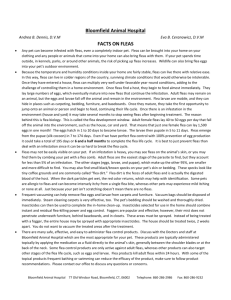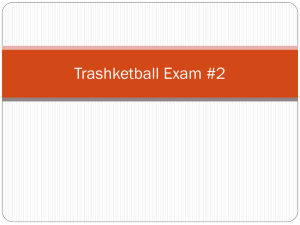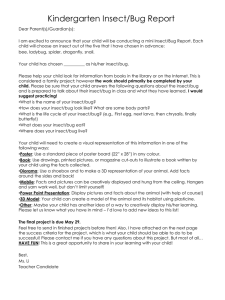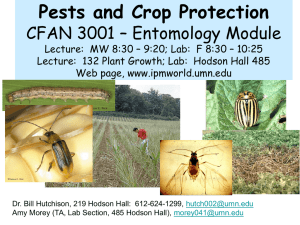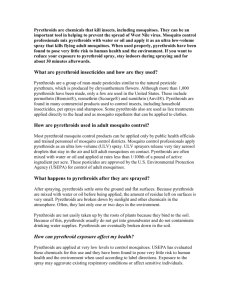Ectoparasites - Intro to Veterinary Technology
advertisement
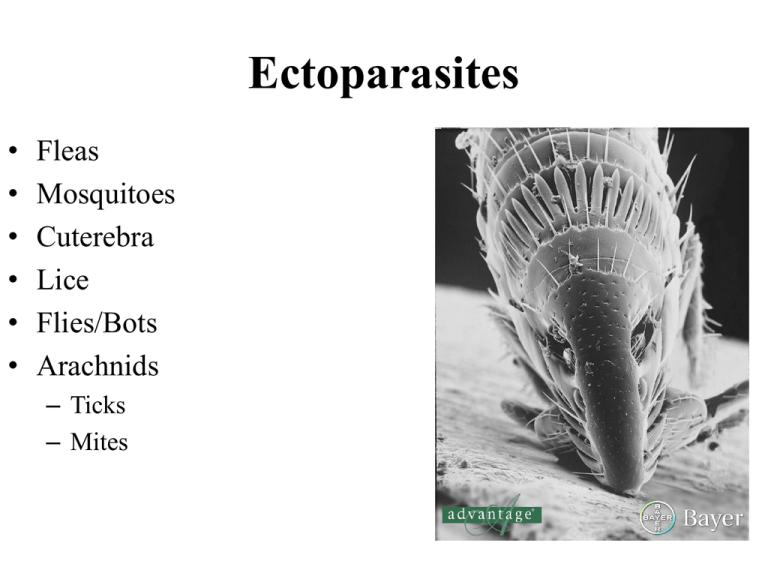
Ectoparasites • • • • • • Fleas Mosquitoes Cuterebra Lice Flies/Bots Arachnids – Ticks – Mites Ectoparasite Treatment • Ectoparasites can be controlled using a variety of different drugs in a variety of different formulations – Sprays – Dips – Pour-ons – Shampoos – Dusts or powders – Foggers – Oral products – Spot-ons – Injectables Chemical Safety in Ectoparasite Treatment • Always read product labels to determine what safety procedures to follow • May need protective clothing • May need special disposal techniques • Proper ventilation is crucial • Most regulated by EPA • Keep and refer to MSDS prior to use and if signs of toxicity occur in the animal Chemicals Used for Ectoparasite Treatment Chlorinated Hydrocarbons: DDT – Lindane shampoo Organophosphates & Carbamates- Adam’s Flea and Tick Dip Pyrethrins and pyrethroids – Bio-spot, K9 Advantix Formamidines: Amitraz- Promeris (Amitraz), Mitaban dip (Amitraz) Imidacloprid- Advantage (imidaclorpid) Fipronil- Frontline (fipronil), Frontline Plus (fipronil and methoprene) Nitenpyram- Capstar (nitenpyram) Insect Growth Regulators- Program, Sentinel (Lufenuron) Insect Repellents- Butox PPG or VIP Fly repellent (butoxypropylene glycol) Others- Rotenone and D-limonene Chlorinated Hydrocarbons • • • • • One of the oldest groups of synthetic insecticides. Resistant to biodegredation (remain in environment for years) Includes DDT (dichlorodiphenyltrichloroethane) Must be certified to apply them. Applied to plants/animals to control insects, eventually washed into streams. High lipid solubility allows accumulation in fish. Affects are more intense higher up food chain. • Decline of bald eagle population traced to fragile egg shells as a result of biological magnification of DDT. Lindane • The only chlorinated hydrocarbon currently used in veterinary medicine today. • Incorporated in some dog shampoos. • Kills insects on contact; directly absorbed into insects and their eggs; also a stomach poison for insects • Can produce harmful side effects in people and pets if absorbed in sufficient quantities. • Owners should wear gloves, apron, boots • Dispose of empty bottles and bath water according to EPA policies • Lindane should never be used on cats, puppies <3 weeks, lactating animals, or food animals. Organophosphates & Carbamates • General names for a broad class of insecticides • Decompose readily in environment; do not pose threat to wildlife. • Among the most widely used of the potent insecticides. • Also have agricultural applications. • Similar clinical signs (SLUDDE) Organophosphates & Carbamates • SLUDDE classic signs of organophosphates and Carbamate toxicity. • Delayed neurotoxicity syndrome has been reported in people, cats, dogs, and livestock; occurs 1-2 weeks after short-term exposure to large doses of some Ops. Organophosphates & Carbamates • As a general rule, these insecticides should not be used on animals recovering from surgery, sick animals, pregnant animals, or animals considered to be stressed. • Found in sprays, dips, dusts, and systemic medications • Carbamates also found in collars and shampoos • With oral products, fleas must bite animal to get medication Organophosphates • • • • Proban® tablets and liquid (cythioate) Escort® (diazinon) Paramite dip® (phosmet) Adam’s Flea and Tick Dip®, Spray®, and Tick Dust® (chlorpyrifos) Carbamates • Mycodex shampoo with carbaryl® (carbaryl) • Sevin Dust® (carbaryl) Pyrethrins and Pyrethroids • Pyrethrins are natural plant products, derived from chrysanthemum flowers • Pyrethroids are synthetic pyrethrins • Very safe; quick kill • Adulticide, insecticide/miticide • Often manufactured with other products such as imidacloprid and pyriproxyfen • Acts on parasite’s nerve cell membrane to paralyze the parasite Pyrethrins and Pyrethroids • May have limited residual effects • Do not use near lakes, ponds, streams (fish easily poisoned with pyrethrins; absorbed through skin) • Labeled for dogs may be too high of concentration for cats • Used in small animals primarily for fleas/ticks • Used in large animals for flies, lice, mites, mosquitos, and ticks • Commonly used in sprays, dips, foggers, pourons, insecticidal ear tags, and premise sprays. Pyrethrins and Pyrethroids Permethrin has been incorporated into some external antiparasitic protocols because of its effectiveness in killing and repelling fleas and ticks. • K9 Advantix and Bio-Spot® for dogs are a couple of examples Formamidine • One of the first effective agents available for demodectic mange in dogs. • Causes excessive activity in parasite’s nervous system • Toxic to cats and rabbits • Animals may show sedation and in-coordination for 24-48 hours after application • Available in collars, topical treatment, dip, or spongeon bath. • Use protective clothing and gloves; use in a wellventilated area Amitraz • ProMeris® for dogs (synergistic with metaflumizone) • Mitaban Dip® • PrevenTIC® collar • Taktic®EC (cattle) Amitraz • Can be very toxic if ingested by animals or people • Amitraz toxicosis is treated with supportive therapy • Taktic has been advocated for some nonresponsive cases of demodectic mange in dogs as an off-label therapy. Owners must be well informed of potential risks of this treatment. Life Cycle of the Flea Life Cycle of the Flea http://www.youtube.com/watch?v=y2gYBdg-VFQ Insect Growth Regulators (IGR) • Insect growth regulators are compounds that affect immature stages of insects and prevent maturation to adults. • Include Insect development inhibitors and juvenile hormone mimics IGR • Insect development inhibitors interfere with development of chitin, which is essential for proper egg formation. The “egg-tooth” used by flea larvae to exit egg is also made of chitin • Insect development inhibitors also inhibits the development of the larval exoskeleton. Insect Growth Regulators • Juvenile hormone mimics prevent fleas from molting to the next stage by interrupting normal molting process. The insect stays in the larval stage and eventually dies. • Insect growth regulators do not affect adult fleas. • Lufenuron, methoprene, and pyriproxyfen are all examples of IGRs. Other IGRs • Ovitrol®(methoprene) is generally regarded as safe. • Female flea absorbs compounds from skin of animal (deposited by flea collar) and it is incorporated into eggs Flea pupae in carpet are protected from methoprene because it binds to fibers in carpet. • Nylar® (pyriproxyfen) - Mostly used in environmental flea control products; may have some activity against adult fleas (but not immediate); more potent than methoprene Other IGRs Imidacloprid • • • • Advantage® Insect neurotoxin Marketed for use in both dogs and cats. Poorly absorbed through skin and kills adult fleas on contact • Wide margin of safety. • Four week residual activity. Fipronil • • • • • • • • Frontline® Frontline Plus (Fipronil with methoprene) Overstimulates insect nervous system causing death Kills adult fleas, ticks, and chewing lice (on contact); controls sarcoptic mange with repeated treatments. Methoprene is an insect growth regulator, which makes Frontline plus® effective against flea eggs and larvae. Applied topically; not absorbed systemically Residual activity, even after bathing Not for use in puppies or kittens <8 weeks of age. Nitenpyram • Capstar® (nitenpyram) • Tablet begins to kill adult fleas within 30 minutes • At least 90% fleas killed in 4 hrs. (dogs); 6 hrs. (cats) • Can safely give a dose as often as Q24h • Can use on puppies and kittens older than 4 weeks and weighing more than 2 lb. • Only kills adult fleas; should also give insect growth regulator (IGR) to control fleas. Lufenuron • • • • • • Program® (lufenuron) The flea component in Sentinel® Interferes with chitin synthesis in flea development Given orally to dogs; orally or SC to cats Fleas must bite the animal to be exposed to the drug. Fleas continue to lay eggs, but eggs fail to develop normally. • Lufenuron is distributed to fat and then leaches slowly back into the body fluids, providing a long duration of activity; therefore drug needs to be given only once monthly. Insect Repellents • Used to repel insects and keep them off of animals • May be used in combination with pyrethrins and pyrethroids • Include sprays, ear tags, and topicals for ear tips • Some products are insecticides as well as repellents • Control mosquitoes, flies, and gnats. Insect Repellents • Butox PPG ® or VIP® Fly Repellent (butoxypropylene glycol) – Used in equine fly repellents because it provides a shine that is of cosmetic value in show animals – Incorporated into flea and tick spray products for use in dogs and cats – Can cause dermal irritation if a harness or collar is applied over the area while the haircoat is still wet with spray. Other External Antiparasitics • Rotenone - A.k.a. “Derris Powder” (derived from derris root) – Ear Miticide®, Mitaplex-R® – Used in dips and pour-on liquids – Toxic to fish and swine; consider runoff possibilities when using. • VIP Flea Dip and Shampoo® (D-limonene) – Derived from citrus peels – Has slight insecticidal activity – Pleasant smell; provides quick kill; may be used with other products

